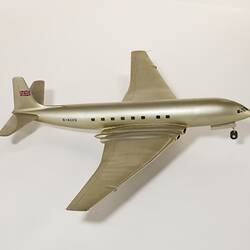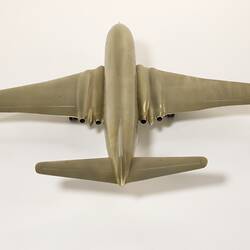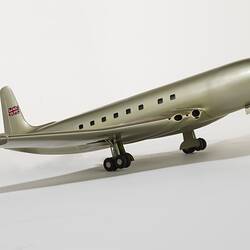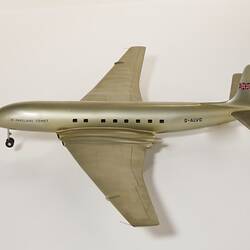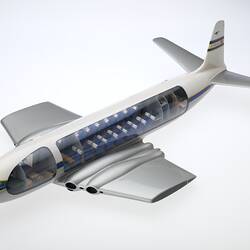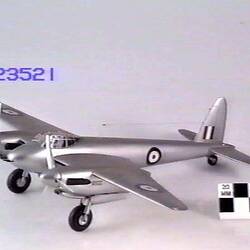Summary
1:32 scale model of a De Havilland DH106 Comet I. The model was made in 1952 and was purchased by the Museum from a commercial model-maker in March 1953. The model was made before the catastrophic accidents that were soon to characterize its service.
Aircraft History:
The DH106 Comet was the first jet airliner used for commercial passenger services. Design work began at the De Havilland Aircraft Company in 1944 with the prototype flying on 27 July 1949. The design was conventional but incorporated the latest knowledge of aerodynamics with the four De Havilland Ghost jet engines mounted inside the wing to minimise drag. Test pilot John Cunningham flew the aircraft on many of the trial and route proving flights in 1950-51. Ten Comet 1 aircraft were delivered to British Overseas Airways Corporation (BOAC) in 1952. Sales were also made to Canada and France.
The proposed trans-Pacific Sydney-Vancouver service by Canadian Pacific Airlines began badly when the first Comet (CF-CUN) 'Empress of Hawaii' crashed in Pakistan in March 1953 on the way to Sydney to begin the first service. Three unexplained crashes followed in May 1953, January 1954 and April 1954, with all passengers and crew being killed after mid-air structural failures. All remaining Comet aircraft were grounded and an exhaustive investigation using hydrostatic (water tank) pressure testing found metal fatigue originating at the corner of a cabin window was at fault. The Comet was re-designed with thicker aluminium skin and rounded cabin windows, but the loss of public confidence and delay gave American firms such as Boeing the lead in jet airliner sales which was never regained by Britain. BOAC used a pair of Comet 4 airliners to fly the first commercial east and west jet airliner crossings of the Atlantic on 4 October 1958.
The new Comet 2, 3 and 4 series operated safely in commercial and military service for many years. The Comet's wing and engine nacelle design was used in the Nimrod maritime patrol aircraft which remains in RAF service.
Physical Description
Silver model aeroplane with four wheels beneath each wing and two front wheels. A British flag is painted on the tail. Airframe Info Manufacturer: De Havilland Model: DH106 Comet 1 Search all De Havilland DH106 Comet 1 Year built: 1949 Construction Number (C/N): 6001 Aircraft Type: Fixed wing multi engine Number of Seats: 39 Number of Engines: 4 Engine Type: Turbojet Engine Manufacturer and Model: Rolls-Royce Ghost 50 Mk1/Ghost DGT3 Also Registered As: G-5-1 De-registered Aircraft Registration Number: G-ALVG Current Status: Broken up EGLF July 1953. Delivery Date: 1949-09-01 Owner Owner: Ministry of Supply Address: United Kingdom
Significance
Quotation from Wikipedia, https://en.wikipedia.org/wiki/De_Havilland_Comet:
'The first prototype DH 106 Comet (carrying Class B markings G-5-1) was completed in 1949, and was initially used to conduct ground tests and brief early flights.[19] The prototype's maiden flight took place on 27 July 1949 out of Hatfield Aerodrome and lasted 31 minutes.[22][23] At the controls was de Havilland chief test pilot John Cunningham, a famous night-fighter pilot of World War II, along with co-pilot Harold 'Tubby' Waters, engineers John Wilson (electrics) and Frank Reynolds (hydraulics), and flight test observer Tony Fairbrother.[24]
'The prototype was registered G-ALVG just before it was publicly displayed at the 1949 Farnborough Airshow prior to the start of flight trials. A year later, the second prototype G-5-2 made its maiden flight. The second prototype was registered G-ALZK in July 1950 and it was used by the BOAC Comet Unit at Hurn from April 1951 to carry out 500 flying hours of crew training and route proving.[25] Australian airline Qantas also sent its own technical experts to observe the performance of the prototypes, seeking to quell internal uncertainty about its prospective Comet purchase.[26] Both prototypes could be externally distinguished from later Comets by the large single-wheeled main landing gear, which was replaced on production models starting with G-ALYP by four-wheeled bogies.[27]'
'The De Havilland DH106 Comet prototype aircraft which had a single main wheel bogie later in December 1950 it received a four wheel bogie for flight trials. Its first flight was on 27th July 1949.' - from https://www.airteamimages.com/de-havilland-comet_g-alvg_de-havilland_82196
The airplane was 93 feet (28.346 meters) long with a wingspan of 115 feet (35.052 meters) and overall height of 29 feet, 6 inches (8.992 meters). The Comet 1 had a maximum takeoff weight of 110,000 pounds (49,895.2 kilograms). It was powered by four de Havilland Engine Company Ghost 50 centrifugal flow turbojet engines, producing 5,000 pounds of thrust, each. This gave it a cruising speed of 460 miles per hour (740.3 kilometres per hour) and cruise altitude of 42,000 feet (12,801.6 meters). The airliner's range was 1,500 miles (2,414 kilometres). Twelve DH. 106 Comet 1 airliners were built. Sources for this information include - https://www.thisdayinaviation.com/8-april-1954/comet-1-cutaway-2-3/
More Information
-
Collecting Areas
-
Acquisition Information
Purchase
-
Modelmaker (Probable)
-
Manufacturer of Item Modelled
De Havilland Aircraft Co. Ltd, Hatfield Aerodrome, Hertfordshire
-
Inscriptions
Registration Number: G-ALVG Current Status: Broken up EGLF July 1953. Delivery Date: 1949-09-01
-
Brand Names
-
Classification
Air transport, Aircraft, Model turbo jet aircraft - passenger
-
Category
-
Discipline
-
Type of item
-
Overall Dimensions
1100 mm (Length), 1300 mm (Width), 300 mm (Height)
-
Model Scale
1:32
-
Keywords
Model Aeroplanes, Passenger Aircraft, Scale Models, Innovation & Design



